Thorsten Kurth
Modulated Adaptive Fourier Neural Operators for Temporal Interpolation of Weather Forecasts
Oct 24, 2024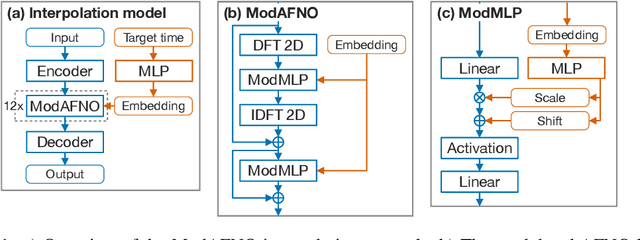
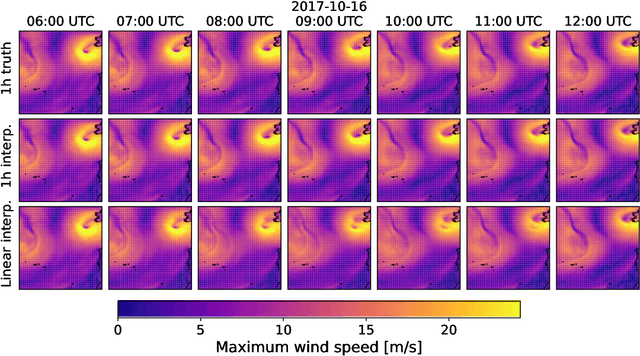
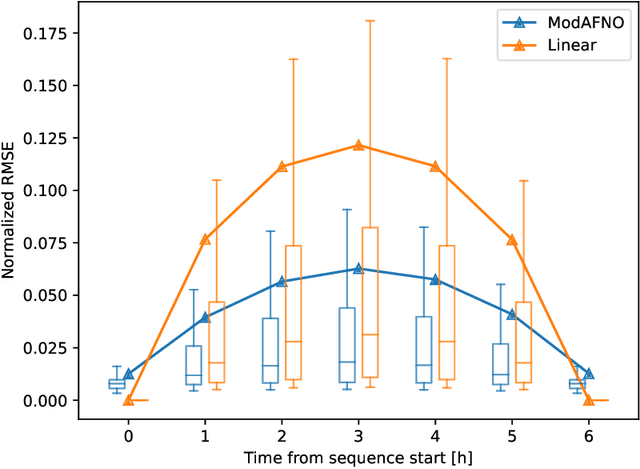
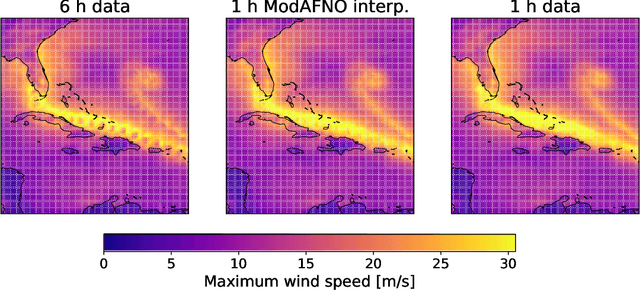
Abstract:Weather and climate data are often available at limited temporal resolution, either due to storage limitations, or in the case of weather forecast models based on deep learning, their inherently long time steps. The coarse temporal resolution makes it difficult to capture rapidly evolving weather events. To address this limitation, we introduce an interpolation model that reconstructs the atmospheric state between two points in time for which the state is known. The model makes use of a novel network layer that modifies the adaptive Fourier neural operator (AFNO), which has been previously used in weather prediction and other applications of machine learning to physics problems. The modulated AFNO (ModAFNO) layer takes an embedding, here computed from the interpolation target time, as an additional input and applies a learned shift-scale operation inside the AFNO layers to adapt them to the target time. Thus, one model can be used to produce all intermediate time steps. Trained to interpolate between two time steps 6 h apart, the ModAFNO-based interpolation model produces 1 h resolution intermediate time steps that are visually nearly indistinguishable from the actual corresponding 1 h resolution data. The model reduces the RMSE loss of reconstructing the intermediate steps by approximately 50% compared to linear interpolation. We also demonstrate its ability to reproduce the statistics of extreme weather events such as hurricanes and heat waves better than 6 h resolution data. The ModAFNO layer is generic and is expected to be applicable to other problems, including weather forecasting with tunable lead time.
Toward Capturing Genetic Epistasis From Multivariate Genome-Wide Association Studies Using Mixed-Precision Kernel Ridge Regression
Sep 03, 2024



Abstract:We exploit the widening margin in tensor-core performance between [FP64/FP32/FP16/INT8,FP64/FP32/FP16/FP8/INT8] on NVIDIA [Ampere,Hopper] GPUs to boost the performance of output accuracy-preserving mixed-precision computation of Genome-Wide Association Studies (GWAS) of 305K patients from the UK BioBank, the largest-ever GWAS cohort studied for genetic epistasis using a multivariate approach. Tile-centric adaptive-precision linear algebraic techniques motivated by reducing data motion gain enhanced significance with low-precision GPU arithmetic. At the core of Kernel Ridge Regression (KRR) techniques for GWAS lie compute-bound cubic-complexity matrix operations that inhibit scaling to aspirational dimensions of the population, genotypes, and phenotypes. We accelerate KRR matrix generation by redesigning the computation for Euclidean distances to engage INT8 tensor cores while exploiting symmetry.We accelerate solution of the regularized KRR systems by deploying a new four-precision Cholesky-based solver, which, at 1.805 mixed-precision ExaOp/s on a nearly full Alps system, outperforms the state-of-the-art CPU-only REGENIE GWAS software by five orders of magnitude.
Huge Ensembles Part I: Design of Ensemble Weather Forecasts using Spherical Fourier Neural Operators
Aug 06, 2024



Abstract:Studying low-likelihood high-impact extreme weather events in a warming world is a significant and challenging task for current ensemble forecasting systems. While these systems presently use up to 100 members, larger ensembles could enrich the sampling of internal variability. They may capture the long tails associated with climate hazards better than traditional ensemble sizes. Due to computational constraints, it is infeasible to generate huge ensembles (comprised of 1,000-10,000 members) with traditional, physics-based numerical models. In this two-part paper, we replace traditional numerical simulations with machine learning (ML) to generate hindcasts of huge ensembles. In Part I, we construct an ensemble weather forecasting system based on Spherical Fourier Neural Operators (SFNO), and we discuss important design decisions for constructing such an ensemble. The ensemble represents model uncertainty through perturbed-parameter techniques, and it represents initial condition uncertainty through bred vectors, which sample the fastest growing modes of the forecast. Using the European Centre for Medium-Range Weather Forecasts Integrated Forecasting System (IFS) as a baseline, we develop an evaluation pipeline composed of mean, spectral, and extreme diagnostics. Using large-scale, distributed SFNOs with 1.1 billion learned parameters, we achieve calibrated probabilistic forecasts. As the trajectories of the individual members diverge, the ML ensemble mean spectra degrade with lead time, consistent with physical expectations. However, the individual ensemble members' spectra stay constant with lead time. Therefore, these members simulate realistic weather states, and the ML ensemble thus passes a crucial spectral test in the literature. The IFS and ML ensembles have similar Extreme Forecast Indices, and we show that the ML extreme weather forecasts are reliable and discriminating.
Huge Ensembles Part II: Properties of a Huge Ensemble of Hindcasts Generated with Spherical Fourier Neural Operators
Aug 02, 2024



Abstract:In Part I, we created an ensemble based on Spherical Fourier Neural Operators. As initial condition perturbations, we used bred vectors, and as model perturbations, we used multiple checkpoints trained independently from scratch. Based on diagnostics that assess the ensemble's physical fidelity, our ensemble has comparable performance to operational weather forecasting systems. However, it requires several orders of magnitude fewer computational resources. Here in Part II, we generate a huge ensemble (HENS), with 7,424 members initialized each day of summer 2023. We enumerate the technical requirements for running huge ensembles at this scale. HENS precisely samples the tails of the forecast distribution and presents a detailed sampling of internal variability. For extreme climate statistics, HENS samples events 4$\sigma$ away from the ensemble mean. At each grid cell, HENS improves the skill of the most accurate ensemble member and enhances coverage of possible future trajectories. As a weather forecasting model, HENS issues extreme weather forecasts with better uncertainty quantification. It also reduces the probability of outlier events, in which the verification value lies outside the ensemble forecast distribution.
Coupled Ocean-Atmosphere Dynamics in a Machine Learning Earth System Model
Jun 12, 2024



Abstract:Seasonal climate forecasts are socioeconomically important for managing the impacts of extreme weather events and for planning in sectors like agriculture and energy. Climate predictability on seasonal timescales is tied to boundary effects of the ocean on the atmosphere and coupled interactions in the ocean-atmosphere system. We present the Ocean-linked-atmosphere (Ola) model, a high-resolution (0.25{\deg}) Artificial Intelligence/ Machine Learning (AI/ML) coupled earth-system model which separately models the ocean and atmosphere dynamics using an autoregressive Spherical Fourier Neural Operator architecture, with a view towards enabling fast, accurate, large ensemble forecasts on the seasonal timescale. We find that Ola exhibits learned characteristics of ocean-atmosphere coupled dynamics including tropical oceanic waves with appropriate phase speeds, and an internally generated El Ni\~no/Southern Oscillation (ENSO) having realistic amplitude, geographic structure, and vertical structure within the ocean mixed layer. We present initial evidence of skill in forecasting the ENSO which compares favorably to the SPEAR model of the Geophysical Fluid Dynamics Laboratory.
Neural Operators with Localized Integral and Differential Kernels
Feb 26, 2024Abstract:Neural operators learn mappings between function spaces, which is practical for learning solution operators of PDEs and other scientific modeling applications. Among them, the Fourier neural operator (FNO) is a popular architecture that performs global convolutions in the Fourier space. However, such global operations are often prone to over-smoothing and may fail to capture local details. In contrast, convolutional neural networks (CNN) can capture local features but are limited to training and inference at a single resolution. In this work, we present a principled approach to operator learning that can capture local features under two frameworks by learning differential operators and integral operators with locally supported kernels. Specifically, inspired by stencil methods, we prove that we obtain differential operators under an appropriate scaling of the kernel values of CNNs. To obtain local integral operators, we utilize suitable basis representations for the kernels based on discrete-continuous convolutions. Both these approaches preserve the properties of operator learning and, hence, the ability to predict at any resolution. Adding our layers to FNOs significantly improves their performance, reducing the relative L2-error by 34-72% in our experiments on turbulent 2D Navier-Stokes fluid flow and the spherical shallow water equations.
A Practical Probabilistic Benchmark for AI Weather Models
Jan 27, 2024Abstract:Since the weather is chaotic, forecasts aim to predict the distribution of future states rather than make a single prediction. Recently, multiple data driven weather models have emerged claiming breakthroughs in skill. However, these have mostly been benchmarked using deterministic skill scores, and little is known about their probabilistic skill. Unfortunately, it is hard to fairly compare AI weather models in a probabilistic sense, since variations in choice of ensemble initialization, definition of state, and noise injection methodology become confounding. Moreover, even obtaining ensemble forecast baselines is a substantial engineering challenge given the data volumes involved. We sidestep both problems by applying a decades-old idea -- lagged ensembles -- whereby an ensemble can be constructed from a moderately-sized library of deterministic forecasts. This allows the first parameter-free intercomparison of leading AI weather models' probabilistic skill against an operational baseline. The results reveal that two leading AI weather models, i.e. GraphCast and Pangu, are tied on the probabilistic CRPS metric even though the former outperforms the latter in deterministic scoring. We also reveal how multiple time-step loss functions, which many data-driven weather models have employed, are counter-productive: they improve deterministic metrics at the cost of increased dissipation, deteriorating probabilistic skill. This is confirmed through ablations applied to a spherical Fourier Neural Operator (SFNO) approach to AI weather forecasting. Separate SFNO ablations modulating effective resolution reveal it has a useful effect on ensemble dispersion relevant to achieving good ensemble calibration. We hope these and forthcoming insights from lagged ensembles can help guide the development of AI weather forecasts and have thus shared the diagnostic code.
ClimSim: An open large-scale dataset for training high-resolution physics emulators in hybrid multi-scale climate simulators
Jun 16, 2023Abstract:Modern climate projections lack adequate spatial and temporal resolution due to computational constraints. A consequence is inaccurate and imprecise prediction of critical processes such as storms. Hybrid methods that combine physics with machine learning (ML) have introduced a new generation of higher fidelity climate simulators that can sidestep Moore's Law by outsourcing compute-hungry, short, high-resolution simulations to ML emulators. However, this hybrid ML-physics simulation approach requires domain-specific treatment and has been inaccessible to ML experts because of lack of training data and relevant, easy-to-use workflows. We present ClimSim, the largest-ever dataset designed for hybrid ML-physics research. It comprises multi-scale climate simulations, developed by a consortium of climate scientists and ML researchers. It consists of 5.7 billion pairs of multivariate input and output vectors that isolate the influence of locally-nested, high-resolution, high-fidelity physics on a host climate simulator's macro-scale physical state. The dataset is global in coverage, spans multiple years at high sampling frequency, and is designed such that resulting emulators are compatible with downstream coupling into operational climate simulators. We implement a range of deterministic and stochastic regression baselines to highlight the ML challenges and their scoring. The data (https://huggingface.co/datasets/LEAP/ClimSim_high-res) and code (https://leap-stc.github.io/ClimSim) are released openly to support the development of hybrid ML-physics and high-fidelity climate simulations for the benefit of science and society.
Spherical Fourier Neural Operators: Learning Stable Dynamics on the Sphere
Jun 06, 2023



Abstract:Fourier Neural Operators (FNOs) have proven to be an efficient and effective method for resolution-independent operator learning in a broad variety of application areas across scientific machine learning. A key reason for their success is their ability to accurately model long-range dependencies in spatio-temporal data by learning global convolutions in a computationally efficient manner. To this end, FNOs rely on the discrete Fourier transform (DFT), however, DFTs cause visual and spectral artifacts as well as pronounced dissipation when learning operators in spherical coordinates since they incorrectly assume a flat geometry. To overcome this limitation, we generalize FNOs on the sphere, introducing Spherical FNOs (SFNOs) for learning operators on spherical geometries. We apply SFNOs to forecasting atmospheric dynamics, and demonstrate stable auto\-regressive rollouts for a year of simulated time (1,460 steps), while retaining physically plausible dynamics. The SFNO has important implications for machine learning-based simulation of climate dynamics that could eventually help accelerate our response to climate change.
FourCastNet: Accelerating Global High-Resolution Weather Forecasting using Adaptive Fourier Neural Operators
Aug 08, 2022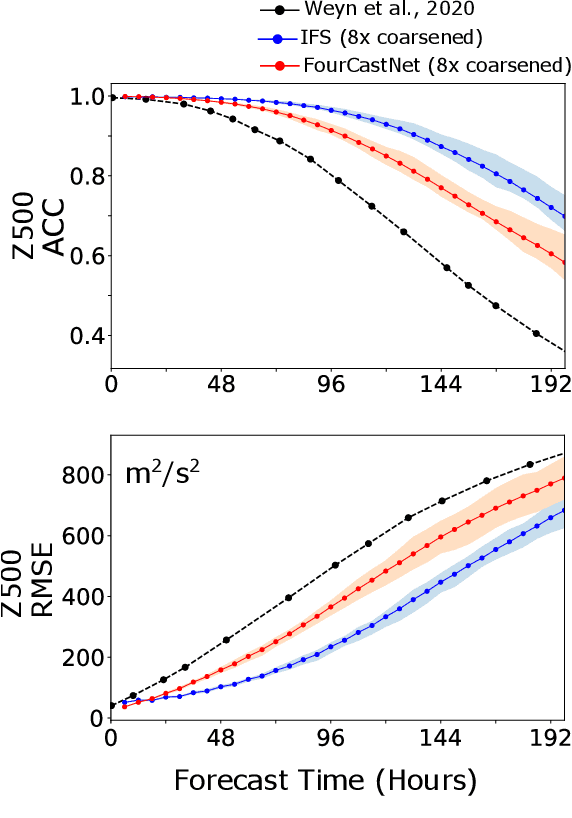
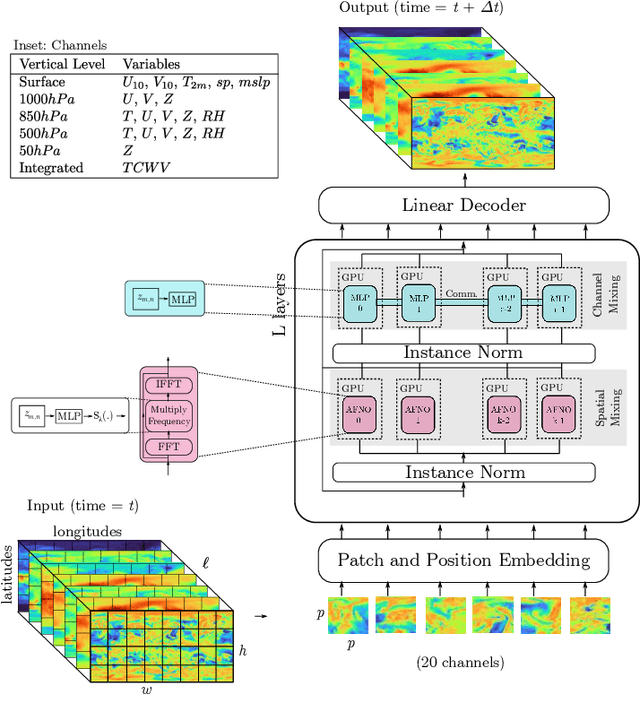

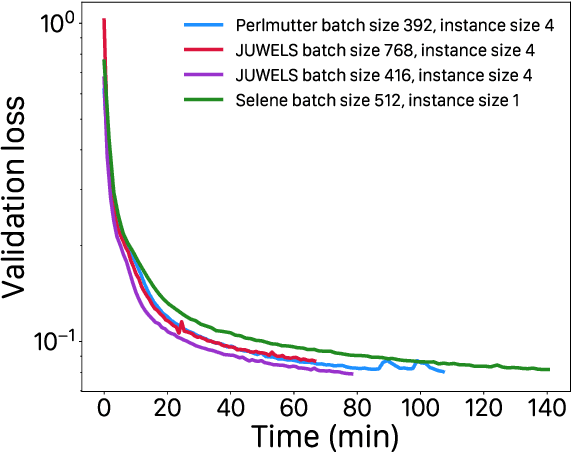
Abstract:Extreme weather amplified by climate change is causing increasingly devastating impacts across the globe. The current use of physics-based numerical weather prediction (NWP) limits accuracy due to high computational cost and strict time-to-solution limits. We report that a data-driven deep learning Earth system emulator, FourCastNet, can predict global weather and generate medium-range forecasts five orders-of-magnitude faster than NWP while approaching state-of-the-art accuracy. FourCast-Net is optimized and scales efficiently on three supercomputing systems: Selene, Perlmutter, and JUWELS Booster up to 3,808 NVIDIA A100 GPUs, attaining 140.8 petaFLOPS in mixed precision (11.9%of peak at that scale). The time-to-solution for training FourCastNet measured on JUWELS Booster on 3,072GPUs is 67.4minutes, resulting in an 80,000times faster time-to-solution relative to state-of-the-art NWP, in inference. FourCastNet produces accurate instantaneous weather predictions for a week in advance, enables enormous ensembles that better capture weather extremes, and supports higher global forecast resolutions.
 Add to Chrome
Add to Chrome Add to Firefox
Add to Firefox Add to Edge
Add to Edge